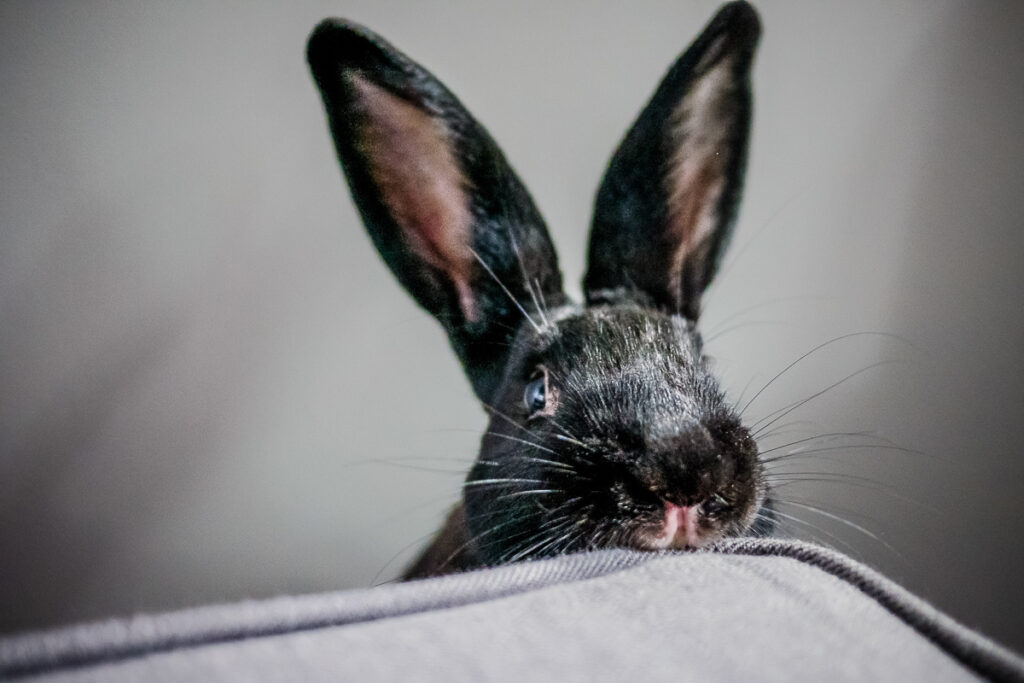Why does your rabbit chew things that aren’t food? Chewing is a completely normal, natural, and necessary activity for rabbits, and it’s also something they find highly enjoyable. Let me share some information to help you understand why rabbits chew and how to prevent them from wreaking havoc on your favorite furniture.
Psychological factors
Female vs Male
Female rabbits often have a stronger urge to burrow than males, but this isn’t the primary reason for their chewing behavior. The age and hormonal factors discussed below also apply to male rabbits. It’s crucial to spay or neuter both male and female rabbits as soon as they become sexually mature, typically around 4 to 6 months old. Providing rabbits with appropriate items to chew on, like hay, cardboard and non-treated grass mats, is essential because rabbits’ teeth continually grow, and they need hard objects to keep them trimmed.
Hormones and Age
Hormones really amp up the natural urge to chew. Is your bunny spayed?
- If your rabbit is young (under 2 years old) spaying is needed. If she is spayed, her chewing tendencies will decrease over time.
- For mature rabbits (over 2 years old) that are unspayed, it’s advisable to spay them after a thorough checkup. Once a rabbit is mature and spayed, her behavior won’t be governed by hormones.
Spayed/neutered rabbits generally chew less as they mature. It’s the equivalent of the “puppy-chewing your-shoe” phase in dogs. That high-energy stage of your bunny’s life won’t last forever.
Personality
Intelligent, outgoing, and affectionate rabbits who seek attention are also often chewers. Is your rabbit chewing to get your attention and focus? Introducing a companion or providing more entertainment options may help reduce her chewing behavior. A bored rabbit is usually a chewing rabbit. It’s important to address a rabbit’s need for intellectual stimulation.
Environmental Factors
Diversions
Continuously look for fun and harmless play activities that your rabbit enjoys. Consider creating a “burrow” or other playspace for her using a cardboard box stuffed with hay or other creative options.
Protecting the Environment
Use boxes or wire baskets to cover wires and cables to safeguard your belongings. Visit a hardware store or amazon’s page for products designed for bunny proofing. They often have wire covers and cord conduits that can be easily applied to your home wires.
Confinement
Temporarily confining your rabbit to a cage or room can buy you time to bunny-proof your space, get her spayed, or wait for her to mature. Remember, it’s not an eitheror, it’s a both-and. Even if you must keep your bunny temporarily confined, you can allow her supervised time out in a small area with safe activities. An extra x-pen and some cardboard is all it takes while you make perperations for long-term bunnyproofing.
Safe Chewing Options
Bunnies need to chew. It bears repeating that the healthiest thing for bunnies to chew is fresh hay — timothy, oat, or orchard grass hay. Replace it at least twice a day.
In addition., give rabbits pieces of the thing they’ve shown they want to chew: their own small towel, for example. Just be sure they aren’t ingesting it. Different bunnies will have a penchant for chewing different things. Here’s a list of safe options:
- Hay (a must everyday)
- Apple, willow, or aspen branches
- Untreated willow tents and baskets
- Pine firewood
- Cotton towels
- Untreated fresh pine lumber securely attached to the pen, cage, or wall
- Willow baskets filled with hay (let her chew the basket too)
- Compressed alfalfa cubes
Toxic Woods
Fruit tree branches like apricot and peach are toxic while attached to the tree but become safe after being cut and dried for a month or more. Ensure your purchases of imported baskets are limited to willow, as it’s the only basket material not treated with pesticides.
carpet Chewing
Yes, chewing carpet can be harmful if your rabbit ingests the fibers. This can present a health hazard, so if your rabbit chews excessively on carpets, consider using a petroleum laxative like Petromalt or Laxatone to prevent blockages.
Digging
Encourage digging behavior. Create a “tunnel” for your rabbit with high sides and an end, covering the bottom with a piece of carpet or similar material. Bunnies love to dig at the end of tunnels. You can achieve the same effect by placing a board with carpet attached between two pieces of heavy furniture against the wall, ensuring the board can’t move.
disciplining your rabbit not to chew
Disciplining your rabbit won’t effectively stop their chewing behavior. But with patience and curiosity, you can provide alternative items for your bunny to chew on.
Making a bunny stop undesirable behavior through discipline (even positive discipline) is challenging, especially if they are left alone for extended periods. Instead, set your rabbit up for success by using the basics of rabbit training: reinforcing desired behaviors, providing an enriched environment with safe items for digging and chewing, and removing access to things they shouldn’t chew on.
Further Reading
Based on an earlier chewing FAQ by Nancy LaRoche.

